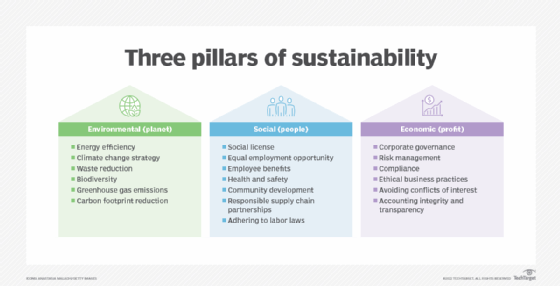
Web3 and sustainability: Benefits and risks
The Web 3.0 concept presents major advances to the World Wide Web, but the tech that underpins it also has environmental impacts, including carbon emissions and e-waste.
The move toward Web 3.0 represents a shift in how society thinks about and uses the internet -- but understanding its environmental impact is critical.
As the next generation of the internet emerges, it promises to create a more decentralized and democratic version of the web. But Web 3.0, or simply Web3, might cause significantly more harm to the environment than the first and current generations of the internet.
What is Web 3.0?
Currently a work in progress, Web3 refers to the third generation of the World Wide Web. Although there's no fully agreed-upon definition, what's clear is that Web3 will rely heavily on AI for intelligence and will depend on decentralized applications and blockchain.
"[Web3 will use] distributed tools to create a decentralized layer on top of the internet," said David Boswell, senior director of community architecture at the Linux Foundation, headquartered in San Francisco. "It's about busting up the centralized model of Web 2.0."
Such blockchain-based tools could include the following:
- Bitcoin and other cryptocurrencies, such as Ethereum.
- Non-fungible tokens.
- Smart contracts.
- Decentralized identifiers.
Although these blockchain-based tools are critical for Web3, they're not the only technologies that will separate Web3 from its predecessors.
AI -- including machine learning and generative AI -- will also be essential to supporting the next version of the internet.

Major environmental concerns with Web 3.0 tech
Web3 promises new capabilities, but its underlying technology poses negative environmental impacts, particularly blockchain as well as many forms of AI. Although there are different types of AI and blockchain, both can be as resource intensive as they are powerful. That resource intensity could have troubling consequences for sustainability initiatives, including massive energy requirements, carbon emissions, waste and e-waste generation.
"Cryptocurrency, especially bitcoin mining and its proof-of-work protocol, has had a phenomenal toll on energy and impact on the environment," said Ari Lightman, a distinguished service professor of digital media and marketing at Carnegie Mellon University's Heinz College of Information Systems and Public Policy.
Proof of work is a consensus algorithm used in blockchain technology to create and confirm transactions. The process uses specialized hardware and software to solve complex mathematical problems, which requires immense computational power.
The Cambridge Centre for Alternative Finance calculates Bitcoin's energy needs, listing its consumption in terawatt-hours (TWh), with one TWh equal to 1 million megawatt hours (MWh). Bitcoin consumed about 107.65 TWh in 2022, according to the CCAF's Cambridge Bitcoin Electricity Consumption Index (CBECI). That's more than the 104 TWh of energy all residential refrigerators in the U.S. use, according to data provided by CBECI.
Furthermore, many fossil fuel resources are required to meet the energy demands of Bitcoin and other Web3 tools.
"The main concern is often top-line energy use, but there are also associated and knock-on effects from that," Boswell said.
Top-line energy use refers to the total energy consumed within a given period. The measurement includes fossil fuels like natural gas and oil, and renewables like solar and wind power.
Knock-on effects are the indirect consequences resulting from a particular action. There are significant environmental consequences from intense energy use. For instance, a rapid increase in energy consumption from implementing Web3 technology can result in stricter land use requirements, or the regulations dictating how companies and consumers can use land in a particular area or region.
There is also the issue of greenhouse gas emissions related to that energy consumption, said Alexander Neumüller, research associate with the Cambridge Centre for Alternative Finance at the University of Cambridge Judge Business School in England.
For example, Bitcoin's massive energy use translates into increased greenhouse gas emissions. Bitcoin contributed some 199.65 million tons of carbon dioxide equivalent (CO2e) to the environment from its 2009 inception to September 2022, according to data from the CBECI.
That figure equals about 223,639 pounds of coal burned, according to the EPA's Greenhouse Gas Equivalencies Calculator.
Almost all of Bitcoin's emissions have occurred since 2018, on the heels of the cryptocurrency's rapid growth.
But Bitcoin isn't the only type of blockchain. Cryptocurrency networks -- such as Ethereum -- that use proof of stake rather than proof of work require less energy and generate less greenhouse gas emissions than Bitcoin. That's because proof of stake requires cryptominers to provide a deposit before moving forward with validating a transaction, thus reducing the amount of validation.
Web3's reliance on AI is also a negative environmental impact.
A single AI model can emit 626,000 pounds of CO2e, or nearly five times the lifetime emissions of the average American car, including the manufacturing of the car itself, according to a July 2019 paper published by the University of Massachusetts.
Another environmental concern of Web3 relates to the hardware, including the server farms, required to power it.
Experts said they expect cloud computing companies, telecommunications providers, cryptominers and others who provide the infrastructure supporting Web3 will have to expand their footprints, adding more equipment and turning it over faster. These processes require more natural resources and generate more e-waste.
As in other areas of IT sustainability, researchers and users will need to understand ways to lessen impact.
Potential sustainability benefits of Web 3.0
Researchers have demonstrated that Web3 tools and technologies have a negative environmental impact. But so do the legacy technologies and processes they're meant to replace. The question is: In comparison to current systems, do Web3 tools have a net negative or positive impact?
Some experts say that digitalized processes are more sustainable than their non-digital counterparts in many cases.
For example, Bitcoin's greenhouse gas emissions are an estimated 86.95 MtCO2e per year compared to gold mining's 100.4 MtCO2e per year, according to data from the CBECI.
Furthermore, some Web3 tools can support sustainability initiatives.
Two case studies published by the Hyperledger Foundation explore how Web3 tools can bring environmental benefits, Boswell said. He pointed to several case studies published by the Hyperledger Foundation that found Web3 tools, including a blockchain-based paperless procurement tool and a global water trading platform using Hyperledger Fabric, supported environmental benefits.
Experts noted that blockchain may help create transparency and verifiable accounting in the carbon market, helping organizations to track their carbon footprint more accurately throughout their supply chains, and to sell and buy carbon credits and carbon offsets.
Making Web 3.0 more environmentally friendly
Some companies are making moves to help Web3 become more sustainable.
The Ethereum blockchain network moved from proof-of-work to proof-of-stake in September 2022, a change -- known as the Merge -- that slashed the network's energy use by 99%, according to Ethereum.
Work is also underway to turn a negative into a positive. Infrastructure implementations that can transfer heat from cryptomining devices to homes and buildings are in the works, according to the February 2023 report "Web3 and Sustainability: How We Can Reduce the Climate Impact of Blockchains, How Blockchains Can Help Reduce Our Own," published by the Linux Foundation.
In addition, some organizations are deliberately locating facilities to access low-cost and abundant renewable energy sources in areas such as Canada, Iceland and Sweden, according to the report.
Experts acknowledge the need to do more. Some are calling for more standards and regulations, including more trustworthy and transparent accounting of environmental impacts.
Technology in all its forms can have positive and negative effects, so we need to consider the consequences of using technology to combat global warming in our decision-making, said Scott Chamberlin, senior director of sustainability software and ecosystems at Intel, headquartered in Santa Clara, Calif., in the "Web3 and Sustainability" report.
For example, a recent poll on cryptocurrency illustrates both its expected growth and some knowledge of its impact on the planet.
About 53% of the 2,000 Americans polled about their attitudes toward cryptocurrency believe that cryptocurrency will be the future of finance, according to a March 2022 poll conducted by OnePoll on behalf of StarkWare, a blockchain development company headquartered in London. That number rose to 68% for respondents between the ages of 35 to 44 years old.
Some respondents had an awareness of cryptocurrency's negative environmental impact.
About 34% of all respondents believed reducing cryptocurrency's carbon footprint is important, with that number rising to 39% for respondents between 35 to 44 years old. The figure increased to 49% for respondents between 25 to 34 years old.
Mary K. Pratt is an award-winning freelance journalist with a focus on covering enterprise IT, cybersecurity management and strategy.








